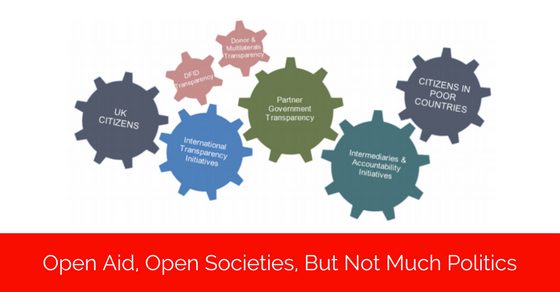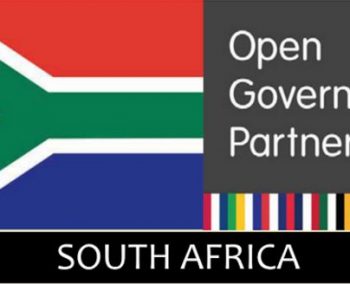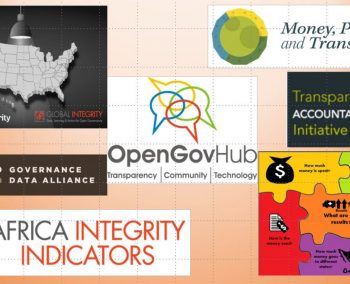Open Aid, Open Societies, But Not Much Politics


February 7, 2018
Alan Hudson, Executive Director
Earlier this week, the UK’s Department for International Development published its new strategy on “Open aid, open societies: A vision for a transparent world”, with the Open Society Foundations (OSF) also publishing their strategy for supporting progress towards more open, accountable and equitable fiscal governance.
This is hugely welcome news, which makes open strategies close to being the new normal, as it should be, for the donors who make up the Transparency and Accountability Initiative. This is a movement that has been led by the Hewlett Foundation, an innovative champion on openness and learning, in relation to their own operations as much as in the wider world, for many years; see here for their May 2017 draft sub-strategies on active citizens and accountable governments, and here for our detailed feedback.
We’re delighted to have the opportunity to engage with DFID and OSF’s thinking. Collaborative learning – sharing strategies, examining evidence, and interrogating assumptions – leads to more effective policy and practice, which in turn can help more countries and people to find pathways out of poverty and towards prosperity.
So, in the spirit of collaborative learning, some thoughts.
First up, DFID, whose new strategy builds on the UK Government’s leadership as regards transparency and governance more broadly, from the early days of the International Aid Transparency Initiative, through the UK’s founding role in both the Extractives Industries Transparency Initiative and the Open Government Partnership, to the 2013 G8 Summit with its focus on transparency, tax and trade, and the 2016 Anti-Corruption Summit. The UK Government deserves much credit for driving the transparency agenda, for ensuring that the global dimensions of governance and corruption challenges are getting the attention they merit, and for recognizing that international credibility on tackling corruption requires domestic leadership.
Three areas that I liked a lot were:
- Global standards: a strong and steadfast commitment, in contrast to the backsliding by others, to spearheading and strengthening global standards – norms and often data standards too – on interlinked issues including company ownership, public contracting, the extractives sector, global commodities trading and tax;
- Use of data: a much-needed shift to giving greater attention to the use of data, rather than hoping that transparency translates easily to accountability and impact (see here for our call for collaborative learning and action around the use of data, particularly fiscal data, and here for some thoughts about the use of budget data specifically); and
- Learning: a call for “much more learning” across global initiatives such as the Open Government Partnership, the Extractives Industries Transparency Initiative and the Construction Sector Transparency Initiative.
Three areas that I had questions about were:
- The “transparency revolution” framing: I worked with the ONE Campaign around the the time of the 2013 G8 Summit in the UK, so I’m not averse to a catchy phrase, but championing the revolutionary powers of transparency does risk marginalizing the role that power and politics plays in processes of social change and development;
- Openness, learning & adaptation: Brief mention is made of locally-informed and politically smart approaches to supporting development, but there’s a missed opportunity to make the connections between two areas of work where DFID has a very strong hand to play; transparency and open governance, and learning-centered and adaptive approaches to governance and development (see here for our take on the value of open governance ; in summary, open environments support learning and adaptation, learning can foster openness, and as such there’s the possibility of a virtuous circle);
- Other agendas: How does DFID’s transparency strategy relate to DFID’s other agendas, for instance on fragility, on gender, and economic development? The transparency strategy does note the connection with the UK’s anti-corruption strategy, but connections with other strands of DFID and the UK Government’s development agenda are less apparent.
So, all in all, very welcome. It’s great to see DFID and the UK Government strengthening their ambition on transparency, openness and anti-corruption, particularly given contrasting moves by the Trump-led administration in the US. And the focus on two “transparency trailblazers”, Ghana and Sierra Leone, as well as research by the DFID-funded Anti-Corruption Evidence Centre in Bangladesh, Nigeria and Tanzania promises much in terms of rich insights about the political dynamics of governance reform and the role that donors can play. But, I’d like to get a better sense of how the existing evidence about whether, how and in what circumstances transparency can make a difference informed the new strategy; and, hear more about how DFID’s transparency commitments are expected to shift the politics and incentives that are at the heart of governance-related challenges.
Next up, some thoughts about the Open Society Foundations’ new strategy on open, accountable and equitable fiscal governance.
 |
Alan Hudson
|
| Alan is our Executive Director. |
One comment on “Open Aid, Open Societies, But Not Much Politics”
Your point on “other agendas” is important. DFID published a tender for e-Procurement a few months ago that did not mention the Open Contracting, one of the international standards highlighted in the strategy. While it’s possible that the winning bidder will include OCDS in its approach, the lack of explicit mention of Open Contracting suggested siloing within DFID that could eventually reduce the effectiveness of the implementation of this strategy.
Reply




